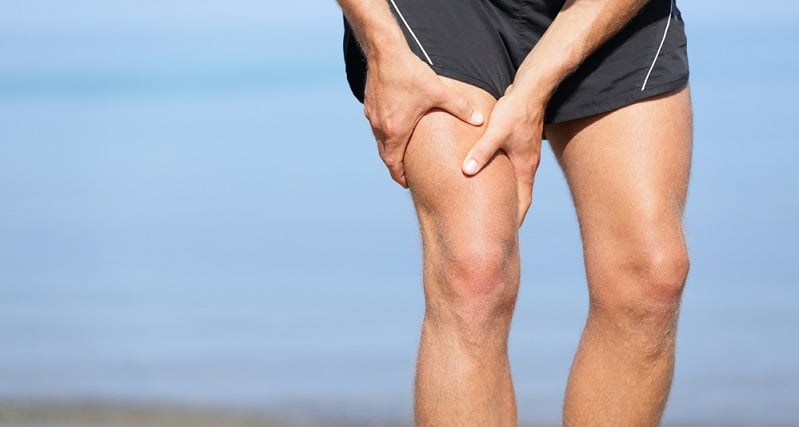Let’s talk about something important today—the not-so-glamorous side of running.
Sure, hitting the pavement or trails is exhilarating, and it does wonders for our physical and mental well-being. But let’s be real here, there’s a downside to this amazing sport: injuries.
Sigh.
Now, I don’t want to be the bearer of bad news, but it’s important to address the elephant in the room. The truth is, if you’re a dedicated runner, chances are you’ll come face to face with an injury sooner or later. It’s like an unwelcome guest crashing your perfect running party. But hey, don’t just take my word for it. Surveys and polls have shown that a staggering 80 percent of runners experience injuries every year. Yikes! Those odds aren’t exactly in our favor, are they?
You see, when we log those miles, it’s the lower limbs that bear the brunt of the impact. So it’s no surprise that injuries love to haunt our knees, feet, calves, shins, and ankles. And it doesn’t stop there—our trusty weight-bearing limbs like thighs, hips, and back are also susceptible to these pesky injuries. It’s like a never-ending battle between our love for running and the potential pitfalls that come with it.
But fret no more.
I’ve got some good news for you today. In this blog post, I’m diving deep into the world of running injuries. We’ll explore some of the most common ones that haunt us runners and, most importantly, I’ll share the best ways to treat and prevent them once and for all. Consider it your survival guide to staying injury-free on your running journey.
Now, before we jump right in, let’s set the ground rules. I want to make it crystal clear that I’m not a certified sports physician, and this blog post can’t provide a one-size-fits-all solution for every injury out there. Safety first, my friends! If you’re dealing with a specific injury, it’s always wise to consult a professional and get personalized advice. They’ll guide you on the appropriate treatment options based on your symptoms and situation.
Alright, now that we’ve got that disclaimer out of the way, let’s embark on this injury-fighting adventure together.!
Overuse Running Injuries Explained
Let’s dive into the intriguing world of running injuries, shall we? Picture this: you’re out there, enjoying the freedom of running, when suddenly, bam!—you find yourself face-to-face with an unwelcome companion called a running injury. It’s like stumbling upon a roadblock on your running journey, and trust me, they can be quite the nuisance.
But before we tackle these injuries head-on, let’s break it down and understand what exactly a running injury is. In simple terms, it’s when you push a specific body part beyond its limits, subjecting it to excessive stress that it just can’t handle anymore. It’s like asking your poor knee or ankle to carry the weight of the world, and eventually, it rebels against you. Ouch!
Here’s the thing: no runner is immune to these pesky overuse injuries. We’re all susceptible to them, whether we’re beginners or seasoned veterans. But here’s the good news—most running injuries are often a result of factors like poor training practices, inadequate conditioning, unsuitable gear, or even our unique biomechanical limitations. In other words, they’re not entirely out of our control.
Now, imagine this scenario: you’re in the midst of your running routine, feeling unstoppable, and suddenly, that dreaded injury strikes. It can be a real buzzkill, forcing you to reduce your training volume or, in severe cases, halt your training altogether due to unbearable pain. These injuries don’t just affect your running—they can interfere with your daily life, making it a struggle to walk, work, and do all the things you love. It’s like putting a temporary pause on your running adventures, and trust me, they suck!
The Most Common Overuse Running injuries
Chronic injuries are, by far, the most common type of injuries, outnumbering acute injuries among runners of every background and training level.
But since they tend to be lower in pain than acute injuries, overuse injuries don’t attract immediate medical attention.
Without further ado, here a list of some of the most common running injuries as well as how to treat and prevent them.
Running Injury. 1 – Achilles Tendinitis
Your Achilles tendon, the largest tendon in your entire body, connects the back of your heel to the powerful calf muscles—the Gastrocnemius and Soleus. It’s like a crucial link in a chain, responsible for absorbing several times your body weight with every single stride. Talk about a load-bearing hero!
But here’s the thing—repetitive stress is the Achilles’ heel of the Achilles tendon. The more you push yourself, the longer and faster you run, the more stress you put on this precious tendon. It’s like subjecting it to a constant barrage of micro-tears, little by little, until it starts screaming for a break. And let me tell you, when it reaches that breaking point, it’s not a pretty sight.
That’s when tendinopathy strikes, bringing along its painful sidekick—good old-fashioned pain. And let’s not forget that sometimes, the pain can be so severe that it forces you to take a step back from your training. Time off from running? Ain’t nobody got time for that!
But hey, let’s not lose hope just yet. Science to the rescue! Countless studies and research papers have delved into the realm of Achilles tendonitis, shedding light on effective ways to treat and prevent this nagging injury. From eccentric calf exercises to proper warm-up routines and even custom orthotics, there’s a whole toolbox of solutions waiting to help you conquer this pesky Achilles villain.
Now, let me share a little anecdote with you. Picture a passionate runner, just like you, facing the wrath of Achilles tendonitis. But instead of giving up and throwing in the towel, they took matters into their own hands. With a combination of rest, physical therapy, and a dash of patience, they bounced back stronger than ever. It’s like witnessing a phoenix rising from the ashes, defying the odds and reclaiming their running glory.
So, my fellow warriors, don’t let Achilles tendonitis bring you down. Armed with the knowledge, advice, and techniques from reputable sources, you have the power to tackle this injury head-on. Take care of your Achilles tendon, listen to your body, and be proactive in your prevention and treatment strategies. Together, we’ll show Achilles tendonitis who’s boss and get back to running with a vengeance. Onward, my friends, to a pain-free and unstoppable running journey!
The Stats
Achilles Tendinitis, the sneaky culprit responsible for about 10 percent of all running injuries.
It’s like that one pesky friend who always manages to find a way to crash the running party. But fear not, my friends, because today I’m diving deep into the contributing factors and symptoms of Achilles Tendinitis.
The Contributor Factors
Now, let’s uncover the villains that often pave the way for Achilles Tendinitis to make its grand entrance. First on the list is the classic case of ramping up your weekly training load too quickly. It’s like going from zero to hero overnight, pushing your body beyond its limits. Remember, slow and steady wins the race when it comes to increasing your training volume—don’t exceed that golden 10 percent per week rule!
But wait, there’s more! Weakness in the posterior chain muscles—those glutes, hamstrings, and calves—can also contribute to the rise of Achilles Tendinitis. It’s like having a weak link in the chain that leaves your precious Achilles tendon vulnerable to injury.
Tight calf muscles, especially the gastrocnemius muscle, can be another culprit. It’s like having a pair of overly tight rubber bands ready to snap at any moment. So, don’t forget to show your calves some love with regular stretching and mobility exercises.
Now, let’s talk about our trusty running companions—our shoes. Wearing improper running shoes is like embarking on a marathon in stilettos. Not the best idea, right? Invest in a good pair of running shoes that provide proper support and cushioning to protect your Achilles tendon from unnecessary stress.
And here’s a gentle reminder: being overweight can also contribute to the development of Achilles Tendinitis. It’s like putting extra pressure on that already hardworking tendon. So, let’s strive for a healthy weight through a balanced lifestyle, giving our Achilles tendon a break.
Symptoms Of Achilles Tendinitis
The Achilles Tendinitis experience can be summed up in two words—tender pain. You might feel this pain in the lower calf near the heel or at the back, especially when you’re running, tip-toeing, or even taking that first step out of bed in the morning. Ouch! It can be severe enough to keep you from running, and we all know how heartbreaking that can be for us passionate runners.
Keep an eye out for any visible swelling or a knot in the affected area. It’s like a little bump reminding you that your Achilles tendon needs some extra TLC. And brace yourself for some strange noises—cracking or popping—when you flex or point your foot. It’s like a little orchestra of sounds, but trust me, you don’t want your Achilles tendon to join in on that symphony.
How To Treat Achilles Tendinitis
If you have Achilles tendinitis, take as many days off as possible. You cannot run through this injury as it will only get worse, which can take more than a few months to fully heal.
Next, apply ice for 10 to 15 minutes on the injured area twice daily.
To soothe the pain, stretch your calves and wear supportive shoes. Research also suggests that compression socks for hard runs relieves and prevents Achilles tightness.
You’ll need clinical treatment for severe cases of the condition. Some options include physical therapy methods of electrical stimulation, such as transcutaneous electrical nerve stimulation (TENS), high-voltage galvanic stimulation (H.V.G.S.), and ultrasound.
How to Prevent Achilles Tendinitis
The Achilles Tendinitis nemesis has shown its face, but fear not, my running comrades! We have an arsenal of preventive measures to keep this injury at bay. Prepare to arm yourselves with knowledge and techniques that will fortify your Achilles tendons like impenetrable shields.
First and foremost, let’s talk about strengthening those posterior muscles. We’re talking about exercises that will make your glutes, hamstrings, and calves sing with joy. Picture yourself doing eccentric heel drops, where you raise your body up on your toes and then slowly lower your heels down below the level of the step. It’s like giving your Achilles tendon a love tap, reminding it of its strength and resilience. And don’t forget about calf raises, lunges, squats, deadlifts, and toe walks—these exercises are like power tools for building a strong posterior chain that will have your Achilles tendon dancing with delight.
Next up, let’s stretch those calves like graceful ballerinas. Imagine lifting your toes back toward your shin while keeping your heel firmly planted on the ground. It’s like a gentle stretch that will lengthen and loosen your calf muscles, giving your Achilles tendon the space it needs to thrive. Trust me, your calves will thank you for it!
Now, let’s address the importance of proper form. Remember, running is not just about putting one foot in front of the other—it’s an art form. Work on improving your foot strike, aiming for a midfoot or forefoot strike rather than landing heavily on your heels. It’s like finding the perfect rhythm in a dance, where every step is light and effortless. And hey, if you’re finding it hard to master, why not recruit a partner or join a running group? They can provide guidance and support, helping you find your running groove and reducing the stress on your Achilles tendon.
Oh, and let’s not forget about the footwear we choose to adorn our feet. When it comes to Achilles tendon protection, opt for shoes with ample support and cushioning. Think of them as the loyal bodyguards of your Achilles tendon, shielding it from potential harm. Flip-flops and high heels? Let’s save those for special occasions and not let them irritate our precious tendons.
Running Injury. 3 – Runner’s Knee
Runners knee is pain caused by the irritation of the cartilage on the underside of the kneecap, nestled within the patellar tendon and connected to the powerful quadriceps muscle group. It’s like a delicate dance between the kneecap and the thigh bone, but sometimes, the rhythm is disrupted, leading to the frustrating symptoms of runner’s knee.
But what causes this disruption in the delicate dance of our knee joint? Ah, let me shed some light on the matter. You see, runner’s knee occurs when the kneecap fails to glide smoothly in the femoral groove at the lower end of the thigh bone. This misalignment can be attributed to various factors, such as muscular imbalances, poor biomechanics, or even overuse and repetitive stress on the knee joint.
The Stats
Ah, the infamous runner’s knee—a formidable adversary that has plagued many a runner on their noble quests. It’s a knee injury that knows no boundaries, affecting runners from all walks of life and training backgrounds. In fact, research has revealed that knee injuries account for a whopping 40 percent of all running-related injuries, with runner’s knee taking a significant slice of that pie.
In a recent poll conducted by runnersworld.com, a staggering 13 percent of runners confessed to experiencing knee pain within the past year.
The Symptoms
You’re out on a run, conquering the miles with determination and gusto. But as you encounter a downhill slope, a sharp twinge of pain reverberates around your kneecap. Descending stairs becomes a dreaded endeavor, as the discomfort intensifies with each step. Even after a long period of sitting, your knee protests as you rise to your feet. And don’t even get me started on the woes of squatting.
These are the telltale signs of patellofemoral pain syndrome, a condition that causes stubborn and tender pain around or behind the patella—the very center of your knee.
How To Treat Runners Knee
The first step on this journey is to heed the whispers of our bodies and listen to their plea for rest. Make sure to decrease his running volume by half. By avoiding consecutive days of running or even taking a temporary break from the sport, you give your knees the chance to find their footing once again.
What’s more?
Make sur
Ru
e to apply ice to your ailing knee for 10 to 15 minutes, multiple times a day. This cool warrior helps to calm the fiery storm within, providing much-needed relief to the throbbing joint. It’s a simple yet powerful tool in our arsenal, cooling the flames of discomfort and hastening the path to recovery.
How to Prevent Runner’s Knee
A group of passionate runners sharing their tales of triumph and resilience, ready to unravel the secrets of knee preservation.
First and foremost, let’s build a fortress of strength around our knees. Imagine the quadriceps, hip flexors, and glutes as the valiant defenders, ensuring our knees stay on the right track over the treacherous femoral groove. Studies have shown that strengthening these support muscles can help alleviate the burden on our knees and improve their alignment.
But strength alone is not enough; flexibility must join the ranks of our knee’s loyal guardians. Imagine the hamstrings and hip flexors as the agile dancers, ready to perform their moves with grace and fluidity. Weaving a routine of stretches and exercises to keep them loose and supple becomes our secret weapon. Through gentle movements and stretches, we unleash the hidden potential within our muscles, enhancing their flexibility and ensuring a harmonious balance in our running stride.
Now, let’s talk about stride length, my fellow road warriors. Imagine your stride as a dance partner, and your knees as the graceful leaders. To reduce the impact on our knees, we must embrace the art of the shorter stride. Picture this: as you take each stride, let your knee softly bend, absorbing the shock with ease. By landing with a slightly bent knee, we unlock the magic of minimizing stress on our knee joints, allowing them to stay strong and resilient throughout our running endeavors.
Research papers and anecdotal experiences remind us of the significance of proper running shoes in the battle against runner’s knee. Seek out the expertise of knowledgeable professionals who can analyze your gait and recommend the ideal footwear for your unique stride. Remember, the right shoes can provide the necessary support and cushioning, reducing the strain on our precious knees and enabling us to conquer the miles with confidence.
Running Injury. 4 – Stress Fractures
While running may seem like a non-contact sport, the repetitive high-impact nature of our beloved activity can put our bones under immense strain, risking the dreaded fracture.
Imagine your bones as the resilient pillars supporting your running endeavors. Day after day, they bear the weight and impact of each stride, absorbing the forces generated by our movements. But like any structure pushed beyond its limits, there comes a breaking point. Stress fractures occur when the cumulative stress on a bone exceeds its threshold, causing tiny cracks to appear. It’s as if our bones whisper a plea for respite, a gentle warning that they can no longer bear the burden we place upon them.
Research papers and studies have shed light on the main cause of stress fractures: excessive training and the resulting sub-maximal stress on the bone. Picture your training as a puzzle, with each piece representing a workout, a run, a training session. Individually, these pieces may not seem significant, but when combined over time, they create a mosaic of stress that can push our bones to their limits.
Now, let’s focus on the battlefield where stress fractures commonly strike among runners. Imagine the metatarsals, those small but crucial bones in your foot, as the delicate soldiers on the frontlines. Among them, the fifth metatarsal, affectionately known as your pinky toe bone, often bears the brunt of stress fractures. It’s as if this little warrior valiantly fights the battle of impact, sometimes succumbing to the relentless forces placed upon it.
Stats
Ah, stress fractures, those formidable foes that can bring even the most dedicated runners to their knees. Studies and research papers have uncovered that stress fractures account for a notable 6 percent of all running injuries. While the percentage may seem small, the impact on our running journeys can be substantial.
Imagine yourself on a typical run, feeling the rhythmic pounding of your feet against the pavement. It’s in these moments that stress fractures can silently weave their way into your bones, like a stealthy infiltrator. The symptoms may start as a whisper, a subtle pain around the affected bone that intensifies the longer you run. It’s as if a tiny crack forms within your very foundation, causing discomfort that begs for attention. But here’s the catch: when you rest, the pain seems to subside, luring you into a false sense of security.
Tenderness and swelling often accompany the pain, like red flags waving in the wind. These symptoms serve as a reminder that your body is sending distress signals, urging you to pay heed. As the stress fracture progresses, the pain can escalate from mild annoyance to a formidable adversary that halts your running endeavors for weeks, even months.
In advanced cases, stress fractures can turn even the simplest act of standing into an uncomfortable and painful ordeal. It’s as if your feet rebel against the weight they bear, reminding you of the delicate balance within your bones. As runners, we understand the significance of staying on our feet, and when stress fractures challenge our every step, we realize the profound impact they can have on our lives.
Now, let’s delve into the contributing factors that make us susceptible to these insidious fractures. Overtraining, that relentless pursuit of pushing our limits beyond reason, can play a significant role. It’s like asking our bones to withstand an unrelenting assault without the chance to recover and rebuild. Our bodies are resilient, but even they have their limits.
But it’s not just training intensity that can tip the scales towards stress fractures. Nutrient deficiencies can weaken our bones, leaving them vulnerable to injury. It’s like trying to build a sturdy fortress with incomplete supplies. Ensuring proper nutrition and a well-balanced diet can provide the building blocks our bones need to withstand the demands of running.
The surface we run on also plays a part in the battle against stress fractures. Just as a delicate artifact is more likely to break when dropped on a hard floor, our bones can suffer when subjected to the unyielding nature of unforgiving surfaces. Running frequently on these hard surfaces can increase the strain on our bones, pushing them closer to their breaking point.
Female runners face their own set of challenges when it comes to stress fractures. Due to factors such as inadequate caloric intake, nutritional deficits, and low estrogen levels, they may be more prone to these fractures.
How to Treat Stress Fractures
Now, let’s talk about the timeline for recovery. Patience is key as it can take anywhere from six to eight weeks to fully bounce back from a stress fracture. Each body is unique, so the duration may vary based on the severity of your injury.
But don’t let the downtime bring you down! Embrace the art of cross-training, where you explore new avenues of fitness while giving your bones the chance to rejuvenate. Picture yourself gliding through the water in aqua jogging, feeling the resistance of each stroke as it strengthens your muscles without the impact on your healing bones. Or imagine the serenity of a yoga session, gently stretching and aligning your body, providing a nurturing environment for your bones to heal. And if you’re craving the thrill of the wheels beneath you, low-intensity cycling can be a wonderful option, allowing you to keep that cardiovascular engine running while giving your bones the TLC they need.
When the time comes to lace up those running shoes again, remember to listen to your body. Start with a gentle jog, testing the waters and gauging any lingering pain. It’s like dipping your toes into a cool stream, feeling the sensations and ensuring that the currents of discomfort have subsided. If you can jog pain-free, with no traces of lingering discomfort, you’re on the right track to resuming your former running routine.
However, if pain persists despite your efforts, it’s essential to take a step back and reevaluate. Our bodies have their own way of telling us when they need more time and attention. In some cases, it may be wise to seek medical intervention and run some tests to gain a deeper understanding of what’s going on beneath the surface. It’s like seeking the guidance of a skilled navigator to steer you through uncharted waters and bring you back to the path of recovery.
How to Prevent Stress Fractures
First and foremost, let’s talk about the importance of finding the perfect running shoes. It’s like finding a trustworthy companion who will support and cushion your every step. Do your research, try on different styles, and find the ones that provide the right blend of stability, cushioning, and support for your unique feet.
Now, let’s dive into the world of strength training. It’s like building a sturdy foundation for your body, strengthening the fortress that protects your bones. Incorporate exercises that target your muscles, particularly those surrounding the legs and core. A balanced routine that includes squats, lunges, deadlifts, and other resistance exercises will help improve your bone density and overall strength.
When it comes to choosing your running terrain, consider the surface beneath your feet. Soft surfaces like grass and dirt trails are your allies, gently absorbing the impact of each stride, while harder surfaces like asphalt and sidewalks can be harsh on your bones. It’s like choosing to dance on a plush carpet instead of a concrete floor.
Now, let’s talk about nutrition, the fuel that nourishes your bones and keeps them strong. Calcium, the superhero of bone health, plays a vital role in preventing stress fractures. Ensure you’re consuming enough calcium-rich foods like dairy products, leafy greens, and fortified foods.
Running Injury. 5 – Iliotibial Band Syndrome (ITBS)
Picture your IT band as a resilient road that stretches from the hip to the thigh, connecting the two like a well-traveled path. It’s like the scenic route that links the bustling city of your pelvis to the vibrant town of your lower limbs. However, as with any journey, sometimes unexpected obstacles arise.
When you run or engage in activities that involve bending your knees, the IT band comes into play, acting as a supportive partner for your knee’s movements, ensuring that your knee flexes and extends smoothly.
But here’s where the story takes a twist. Imagine this: you’ve been on the road for a while, constantly rubbing against the side of the femur as your knee moves back and forth. It’s like the constant friction between two surfaces, gradually wearing down the harmony of the journey. Over time, this repetitive motion can lead to irritation, causing pain and inflammation to rear its unwelcome head.
Research and studies have shed light on the causes of this pesky syndrome. Factors such as overuse, muscle imbalances, and poor biomechanics can contribute to the development of IT band syndrome. It’s like an ensemble of circumstances, each playing their part in the emergence of this uncomfortable condition.
Stats
Surveys and studies have revealed that I.T.B.S. accounts for approximately 12 percent of all running injuries. It’s like a mischievous troublemaker lurking in the shadows, waiting to pounce on unsuspecting runners. But fear not, for knowledge is power, and understanding the signs and symptoms is key.
Symptoms
In the early stages of I.T.B.S., you may experience a stinging sensation on the outside of your knee. It’s as if a mischievous needle is pricking at your joint, mimicking a knee injury. However, it’s crucial to recognize that I.T.B.S. is a different beast altogether, requiring its unique approach to treatment and management.
Now, let’s unravel the contributing factors that invite this troublesome condition into our running lives. It’s like solving a puzzle, piecing together the elements that lead to the emergence of I.T.B.S.
The Causes
One factor to consider is the temptation to push ourselves too hard, too soon. It’s like an overzealous sprinter bolting out of the starting blocks, disregarding the need for gradual progress. Listening to our bodies and gradually increasing our training load can help us avoid falling into the clutches of I.T.B.S.
Weakness in the hip abductor and gluteal muscles can also be a contributing factor. Picture these muscles as the sturdy pillars supporting your running form. When they are weakened or imbalanced, the strain on your IT band increases. Incorporating targeted exercises to strengthen these muscles can help restore balance and alleviate the burden on your IT band.
Runners with leg-length discrepancies or those who overpronate are also more prone to I.T.B.S. It’s like having a slightly uneven road or a car with misaligned wheels. Over time, these imbalances can lead to excessive stress on the IT band, paving the way for discomfort and pain. Seeking professional guidance, such as gait analysis or orthotic inserts, can help address these underlying issues and set you on a smoother running path.
Furthermore, research has shown that runners with a body mass index (B.M.I.) of 25 or higher who engage in weekly runs of two hours or more are at a heightened risk of developing I.T.B.S. It’s like carrying excess baggage on a challenging journey. The added weight places extra strain on the IT band, increasing the likelihood of irritation and inflammation. Keeping a balanced and healthy B.M.I., along with gradual training progressions, can help minimize the impact on your IT band.
How to Treat Iliotibial Band Syndrome
When it comes to preventing injury, it’s like walking a tightrope—a delicate balance that can mean the difference between continued progress or a painful setback. Let’s explore some strategies to navigate this tightrope and keep ourselves on the path to success.
Imagine this: you’re out on your usual running route, feeling invincible as you conquer each mile. But suddenly, a slight twinge of discomfort begins to nag at you. It’s like a subtle whisper, a gentle reminder from your body that something might be amiss. This is the moment to pay attention and take action.
At the first sign of trouble, it’s crucial to heed the warning and make adjustments. Picture it as a yellow caution sign along your running journey. One effective approach is to reduce your mileage by 50 percent for a couple of weeks. It’s like applying the brakes, allowing your body the necessary time and space to heal and recover. By taking this proactive step, you could prevent a minor annoyance from spiraling into a more serious injury.
On the flip side, ignoring those warning signs and stubbornly pushing through at your typical mileage is like turning a blind eye to a ticking time bomb. It’s like pouring fuel on a smoldering fire, exacerbating the issue and potentially leading to a longer road to recovery. Remember, our bodies are resilient, but they also have limits. Respecting those limits is key to long-term success.
During this recovery period, embrace the power of the R.I.C.E method. Rest, ice, compress, and elevate—like a soothing balm for your body. Allow yourself the time to heal by resting and avoiding activities that aggravate the pain. Apply ice to reduce inflammation, gently compress the affected area for support, and elevate it to alleviate swelling. This combination of care can work wonders in easing your discomfort.
However, if the pain persists and becomes too much to handle, it might be time to seek professional help. Booking a physiotherapy appointment can provide valuable insights and targeted treatment options. Additionally, non-steroidal anti-inflammatory drugs (NSAIDs) can offer temporary relief. But be mindful not to rely solely on pills to mask the pain. It’s like using a band-aid without addressing the underlying issue. Taking the necessary steps to address the root cause of the problem is always the best approach.
How To Prevent Iliotibial Band Syndrome
Imagine this: you’re gearing up for a run, lacing up your shoes, and preparing to hit the pavement. But before you take off, let’s take a moment to give your body the love and attention it deserves. A proper warm-up is like a gentle wake-up call to your muscles, preparing them for the demands of the road ahead. Engage in dynamic stretches and movements that activate your hips and legs, getting them ready for the miles that await.
Now, let’s talk about strengthening those hip abductors—the unsung heroes that provide stability and support to your running form. Think of them as the sturdy pillars that keep your body in alignment, preventing unnecessary stress on your IT band. Exercises such as side leg lifts, lateral side steps, and one-legged squats are like power tools for your hip abductors. Incorporating them into your resistance training routine can work wonders in fortifying these muscles, making them resilient against the onslaught of ITBS.
In the realm of running, stride length and cadence are like the yin and yang—a delicate balance that can make or break your running experience. When it comes to ITBS prevention, consider shortening your stride and increasing your cadence turnover. It’s like finding the perfect rhythm in a song, where your feet gracefully land and take off with each step. This adjustment can help reduce the stress placed on your IT band, allowing for a smoother and more efficient running motion.
Ah, the famous 10% rule—a principle that whispers words of wisdom to all runners. It’s a gentle reminder to respect the limits of your body, especially when increasing your mileage. The rule suggests that you should not increase your weekly mileage by more than 10% to avoid overloading your muscles and joints. Think of it as nurturing a delicate plant, allowing it to grow and flourish at a steady and sustainable pace. By embracing this principle, you give your body the chance to adapt gradually, minimizing the risk of ITBS and other running-related injuries.
Running Injury. 6 – Plantar Fasciitis
Picture this: you’re lacing up your running shoes, ready to embark on a new adventure. Little do you know, there’s a band of warriors beneath the surface of your foot, tirelessly working to provide support and stability—the plantar fascia. This mighty band of ligaments and tendons, akin to the strings of a musical instrument, extends from the heel to the toes, joining the heel and forefoot together. It acts as a protective shield, offering crucial arch support for every step you take.
Now, let’s dive into the numbers. Plantar fasciitis, the notorious culprit behind heel pain, is quite the common ailment among runners, accounting for approximately 10 to 15 percent of all running injuries. A poll conducted by runnersworld.com unveiled that a staggering 10 percent of their readers experienced the sting of this injury within the past year. These statistics highlight the significance of this condition and the importance of understanding how to prevent and treat it effectively.
Symptoms of Plantar Fasciitis
Let’s delve into the fascinating world of this condition and uncover its secrets, so you can understand the factors at play and find effective ways to kick that pain to the curb.
Imagine this: you lace up your running shoes, excited to hit the pavement and conquer the miles ahead. But as soon as your foot touches the ground, a sharp, tight sensation grips your heel. It’s as if you’ve inadvertently stepped on a nail or find yourself treading on a precarious path of shattered glass. Ouch! That’s the kind of pain that plantar fasciitis brings to the party.
Plantar fasciitis can turn the simple act of walking or running into a painful ordeal. The most common symptom is a tight and tender sensation at the base of your heel, ranging from mildly irritating to downright excruciating. It’s like having a persistent thorn in your shoe, constantly reminding you of its presence with each step you take.
Now, let’s uncover the main factors that contribute to the development of this troublesome condition. Picture your foot as a complex ecosystem, with various components working in harmony to support your every movement. However, when imbalances occur, trouble can brew, leading to the onset of plantar fasciitis.
One key factor is the weakness and dysfunction of the muscles within your foot. Think of these muscles as the pillars of support for your heel, responsible for distributing the load and keeping everything in proper alignment. When these muscles are weak or not functioning optimally, the burden falls disproportionately on your heel, causing it to endure more stress than it can handle. It’s like asking a single pillar to bear the weight of an entire building—it’s bound to crumble under the pressure.
Prolonged periods of standing on hard surfaces without supportive footwear can also contribute to the development of plantar fasciitis. Imagine standing on a concrete floor for hours on end, with no cushioning or arch support to alleviate the strain. It’s like subjecting your feet to an arduous test of endurance, where they bear the brunt of the unforgiving surface. Over time, this constant stress can lead to the inflammation and pain associated with plantar fasciitis.
Another fascinating factor to consider is the uniqueness of your feet. Some runners may have abnormal feet, characterized by either a high arch or a low arch. These variations can impact the way your foot absorbs shock and distributes forces during each step. It’s like having a unique blueprint for your feet—a one-of-a-kind design that may require some extra attention and care to keep everything in balance.
How to Treat Plantar Fasciitis
Imagine this: you lace up your running shoes, eager to conquer the world with each stride. But as soon as your foot hits the ground, a sharp pang shoots through your heel, almost like a jolt of lightning. It’s as if a mischievous fairy has hidden a pebble of pain in your shoe, determined to sabotage your every step. That’s the telltale sign of plantar fasciitis, my friend—an unwelcome guest that can make each run feel like an uphill battle.
So, how can you fight back against this heel-hijacking villain? Let’s start with some tried-and-true techniques that can help alleviate the pain and promote healing.
Step one: Take a break from running. Yes, I know it’s tough to press pause on your passion, but trust me, giving your foot some rest is crucial for recovery. Especially if the pain is severe, it’s essential to step back and allow your body time to heal. But don’t worry, it doesn’t mean you have to abandon all activity. Engage in low-impact exercises like swimming or cycling to maintain your fitness level while giving your foot a well-deserved break.
Now, let’s talk about the power of stretching. Imagine your plantar fascia as a resilient rubber band. When it’s tight and tense, it can cause discomfort and pain. But fear not, my friend, for stretching can be your secret weapon in the battle against plantar fasciitis. Regularly stretching the fascia tissue, as well as your calf muscles, can help relieve tension and promote flexibility. Picture it as giving your foot a gentle, rejuvenating stretch, like a yoga class for your arches.
But why stop there? The magic of self-massage awaits! Grab a tennis ball or a frozen water bottle and let it be your foot’s best friend. Roll your injured foot over the ball or bottle for a few minutes, several times a day. It’s like giving your foot a refreshing massage, soothing the inflamed tissue and providing relief. And for an extra touch of relaxation, a foam roller can work wonders in loosening up the plantar fascia. Think of it as treating your foot to a spa day—indulging in some well-deserved pampering.
Running Injury. 7 – Shin Splints
Picture this: you lace up your running shoes, ready to conquer the road ahead. But as you hit the pavement, a dull ache begins to radiate along the front portion of your lower leg, as if a tiny army of invisible warriors is diligently hammering away at your shinbone. These warriors are none other than shin splints, the inflammation that can make each stride a painful endeavor.
Now, let’s dig deeper and understand the precise cause of this overuse injury. Imagine your connective tissues as a delicate web that supports and cushions your lower leg. With each step you take, this web is subjected to microtrauma—tiny tears and damage that accumulate over time. It’s like a battle waged between your running routine and the connective tissues in your lower leg, resulting in inflammation and discomfort.
But where exactly is the battlefield? Shin splints target the tendons and muscles that surround your tibia, the mighty shinbone. This bustling area becomes a hotspot for inflammation, as if it’s become a bustling city besieged by the relentless forces of pain.
Now, let’s delve into the numbers. Shin splints have a knack for targeting beginners and those returning to running after a prolonged break. It’s like a rite of passage—a test that many runners face when they first embark on their running journey or when they try to pick up the pace after a hiatus. Surveys have revealed that shin splints account for a substantial portion, approximately 15 to 20 percent, of all running injuries. These numbers highlight the prevalence and significance of this condition among the running community.
Symptoms Of Shin Splints
The pain of medial tibial stress syndrome can range from a mild annoyance to an excruciating ordeal. It’s like a spectrum, with each step serving as a gauge for the intensity of the battle being fought within your leg. You might feel it primarily along the inside of your shin, roughly halfway down, or it may encompass the entire length of the bone. It’s a relentless companion that can make its presence known during your runs, and in some cases, even at rest.
But what are the contributing factors that give rise to this unwelcome companion? Let’s explore some intriguing insights:
Drastic changes in training volume can be a culprit in triggering medial tibial stress syndrome. Imagine your body as a finely tuned instrument, accustomed to a certain level of stress and impact. When you suddenly ramp up the intensity, especially with sprint training, it’s like pushing that instrument beyond its limits, causing it to rebel and protest.
Your choice of footwear can also play a significant role in the development of shin pain. Picture your shoes as loyal allies in your running journey. If they’re the wrong fit or excessively worn, they can betray you, leading to increased stress on your shins. It’s like having a pair of unreliable sidekicks, undermining your efforts to conquer the road.
The surfaces you run on can be deceptive terrain that either supports or sabotages your shins. Imagine running on a hard surface, like a concrete jungle. Each impact reverberates through your lower leg, amplifying the strain on your shins. Similarly, running on cambered terrains—slightly arched surfaces—can throw off the alignment of your legs, placing uneven pressure on your shins. It’s like navigating a treacherous landscape, where each step can make or break your journey.
Now, let’s talk about arches—those unique contours of your feet. Having high arches or flat feet can predispose you to medial tibial stress syndrome. It’s not a matter of fault or blame; it’s simply the hand you’ve been dealt. High arches can create excessive rigidity and limited shock absorption, while flat feet may lack the necessary support and stability.
How To Treat Shin Splints
When it comes to shin splints, early intervention is crucial. As soon as you feel that familiar twinge of pain, take a step back and listen to your body’s warning signals. Reduce your training volume for a couple of weeks, allowing your shins to recover and heal.
But simply reducing your mileage is not enough. Treat your injured shins with care by icing them for 15 to 20 minutes each day and elevating them at night to alleviate swelling. Imagine it as giving your shins a refreshing ice bath and tucking them in with a cozy blanket for a restful night’s sleep.
Now, let’s talk about some additional strategies to aid in your recovery and prevent future bouts of shin splints. Regular stretching can work wonders in keeping your shin muscles supple and resilient. Incorporate specific stretches that target the muscles around your shins, such as toe taps and heel walks. It’s like giving your shins a gentle massage, promoting flexibility and preventing tightness from taking hold.
If you’re in need of some extra support, consider using over-the-counter anti-inflammatory drugs or experimenting with Kinesio tape and neoprene sleeves. They can provide some relief and stability to your shins during your runs. It’s like equipping your shins with protective gear, shielding them from unnecessary stress and strain
Rest days are essential for recovery, but that doesn’t mean you have to abandon all physical activity. Embrace low-impact exercises like swimming, biking, pool running, or yoga to maintain your fitness levels without putting excessive weight-bearing stress on your shins. It’s like taking a detour on your running journey, exploring alternative paths that still keep you on the road to fitness.
When you finally bid farewell to shin pain and return to running, ensure that you do so pain-free. Gradually increase your mileage and intensity, allowing your body to adapt and strengthen over time. Remember, it’s not just about applying the RICE method—it’s about ensuring that your shins have fully recovered before hitting the pavement again.
If your shin splint troubles persist for more than a month despite your best efforts, it may be time to seek the guidance of a physician. They can conduct a thorough examination and provide tailored advice for your specific situation. It’s like calling in a skilled strategist to assess the battlefield and devise a winning plan.
Prevention
Gradual progression is key. Increase your training volume slowly, allowing your body to adapt and build resilience.
Pay attention to your anterior tibialis muscle—the unsung hero on the front of your shin. Strengthen it with exercises like heel walks and toe taps, giving it the power to withstand the demands of running.
Don’t forget about the importance of proper nutrition. Boost your calcium and Vitamin D intake to support strong and healthy bones.
Strengthen your calves, for they are vital supporters of your lower legs. Toe raises, eccentric heel drops, and calf raises can help fortify these essential muscles.
If you have flat feet, consider consulting with a doctor about the potential benefits of orthotics. They can provide additional support and stability, acting as your trusted allies in the battle against shin splints.
Give compression running socks a try. These magical socks apply gentle pressure to your lower legs, improving blood circulation and reducing muscle vibrations during your runs.
Running Injury. 8 – Patellar Tendinitis
Imagine your patellar tendon as a sturdy bridge connecting your kneecap to the top of your tibia, the mighty shinbone. This tendon plays a crucial role in leg extension during activities like running and bending motions at the knee. It’s like the support beam that allows you to push off the ground with each powerful stride.
However, the repetitive and high-impact nature of running can sometimes wreak havoc on this resilient tendon. The constant stress placed upon it can lead to small tears, causing inflammation, pain, and swelling. It’s as if the bridge is being pushed to its limits, gradually developing cracks that weaken its structural integrity.
Stats
Research has shown that patellar tendinitis affects approximately 11 percent of runners. That’s a significant number of athletes grappling with this frustrating condition.
The Symptoms
When it comes to patellar tendinitis, the pain tends to center around the bottom of your kneecap, right over the patellar tendon. However, the tenderness can manifest anywhere along this crucial structure. It’s like a troublesome ache that lingers, making its presence known whenever you engage in activities that involve knee bending—kneeling, squatting, sitting, jumping, or even ascending stairs.
The Contributing Factors
When it comes to patellar tendinitis, several factors can contribute to its development. Overtraining is like pushing the pedal to the metal without giving your body a chance to catch its breath. It’s like revving your engine without ever taking a pit stop. The constant strain on your patellar tendon can eventually lead to inflammation and pain.
Too much hill training can also be a culprit. While conquering those inclines can make you feel like a champion, the repetitive stress on your knees during uphill runs can take a toll on your patellar tendon. It’s like constantly climbing a without giving your legs a break.
Running on uneven or slanted surfaces is another sneaky trigger for patellar tendinitis. Imagine navigating a rocky terrain where every step requires additional effort to maintain balance. Your knees have to work overtime to stabilize your body, and the patellar tendon may suffer the consequences.
Biomechanical challenges, such as overpronation, can also put extra strain on your patellar tendon. It’s like driving with misaligned wheels that cause uneven wear and tear on your tires. Similarly, when your biomechanics are off-kilter, your knees may bear the brunt of the load, leading to tendon inflammation and discomfort.
Treatment
When you first notice the pain, it’s essential to take a step back from high-impact training and give your body some well-deserved recovery time. Think of it as hitting the pause button on your running routine to allow your patellar tendon to heal properly.
You may need to reduce your weekly mileage or even temporarily halt your running altogether. It’s like taking a detour on your running journey, exploring alternative activities that don’t put excessive stress on your knees. Give your body the time it needs to transition from the acute phase of pain to the healing phase.
During this recovery period, ice becomes your best friend. Apply an ice pack to the affected area for 15 to 20 minutes, three to four times a day. It’s like giving your knees a chilly embrace, reducing inflammation, and providing relief
Once you’re pain-free, you can gradually reintroduce running into your routine. Start with shorter distances and listen to your body. If the pain returns, take a step back and adjust your training accordingly. It’s like testing the waters, slowly wading in before diving back into your regular running regimen.
Prevention
Strengthening the muscles around your knees is key to providing extra support to the patellar tendon. Think of it as building a sturdy fortress around your knees, reinforcing their stability and resilience.
When increasing your mileage, remember the golden rule: no more than a 10 percent increase from one week to the next. It’s like taking small, calculated steps instead of giant leaps. Prioritize recovery and give your body time to adapt to the increasing demands of running.
Don’t neglect the importance of flexibility. Keeping your calves and hamstrings loose and limber can help alleviate strain on your knees. It’s like keeping your muscles well-oiled and ready for action.
Running Injury. 9 – Muscle Strains
Picture this: you’re out on the open road, feeling the rhythm of your strides, when suddenly, a sharp pain shoots through the back of your thigh. It’s like a sudden hiccup in your running symphony, throwing off your stride and leaving you in discomfort. That, my friend, is a hamstring strain—a slight tear or overextension of the muscles that reside in the back of your thigh, responsible for bending your knee.
The hamstrings, composed of the semitendinosus, semimembranosus, and biceps femoris muscles, are the workhorses that propel you forward with every step. But when pushed beyond their limits or subjected to sudden bursts of speed, they can rebel against you, causing pain and frustration.
Your muscles are like untrained warriors stepping onto the battlefield for the first time. They haven’t developed the endurance and resilience required for the high-impact nature of running.
If you’re a speed demon, addicted to the thrill of sprinting or engaging in frequent speedwork sessions, you may be dancing on a fine line. Pushing your muscles to their absolute limit in these intense bouts can increase the risk of hamstring strains. It’s like revving your engine to its maximum capacity without giving it a chance to cool down—it’s a recipe for trouble.
Skipping a proper warm-up is another red flag that can lead you straight into the arms of a hamstring strain. Think of your muscles as a group of friends preparing for a thrilling adventure. They need time to loosen up, stretch, and wake up from their slumber before embarking on a vigorous run. Neglecting this crucial step is like sending your friends off on a daring expedition without any preparation—it’s a surefire way to encounter setbacks.
Symptoms of Muscle Strains
When your hamstrings decide to rebel, they make their presence known through tender stiffness and pain. It’s like a grumpy old man refusing to stretch his legs in the morning, protesting with every movement. Trying to stretch your hamstrings, accelerating or decelerating during a run, or engaging in any knee-bending activity can elicit discomfort and remind you of their presence.
Treatment
Most hamstring strains can be handled right in the comfort of your own home, without the need for dramatic interventions. It’s not as dire as a ligament sprain, where the very fibers of your body’s support system are torn asunder.
If you suspect a hamstring strain, the first rule of thumb is to halt your running endeavors immediately and apply the tried-and-true RICE method.
Picture this: you’re lounging on your couch, legs elevated on a plush pillow, a cold pack soothingly numbing the affected area. This is the essence of the RICE method—Rest, Ice, Compression, and Elevation. Give yourself a well-deserved break from running for a couple of days, or even longer if needed. Ice the painful area for 15 to 20 minutes a few times a day, allowing the cool embrace to reduce swelling and kickstart the healing process. And don’t forget to elevate that injured leg, as if it were the crown jewel of your recovery kingdom.
Now, here’s the part where patience becomes your greatest ally. Recovery time for hamstring strains can vary from runner to runner, taking anywhere from a mere two weeks to a more challenging three months. The severity of the strain plays a significant role in determining the duration of your healing journey. So, be kind to your body, listen to its cues, and allow it the time it needs to mend those strained hamstrings.
But my dear runners, prevention is always the best medicine. Let’s unlock the secrets to ward off those pesky muscle strains and keep our hamstrings happy and healthy. It all begins with a proper warm-up, as if you were enticing your muscles into an exhilarating dance. Before each run, take a few moments to awaken your body with light jogging, dynamic exercises, and stretches that ignite your muscles and prepare them for the journey ahead.
And for those sprint enthusiasts and speedwork aficionados, pay extra attention to your warm-up routine. Take 15 to 20 minutes to engage in a dynamic warm-up that primes your body for those lightning-fast bursts of speed. Embrace the power of inchworms, squats, and lunges, unleashing your inner athlete and giving your hamstrings the attention they deserve.
Additional resource – How to stop runners toes
More Injuries and Pains To Deal With When Exercising
The above list only covers a small portion of injuries you can encounter when exercising regularly. So, as a bonus, I decided to share a few more so you can protect yourself out there, whether when running or cross-training.
Enjoy!
Blisters
Let’s start with those dreaded blisters. Picture this: you’re out on a run, feeling the wind on your face and the rhythm in your stride, when suddenly, a tiny demon starts rubbing your skin raw. Yes, we’re talking about blisters—those fluid-filled sacks that can turn a blissful run into a painful ordeal. But fear not, my fellow runners, for there are ways to combat these pesky blisters.
Prevent it
Blisters are born from the friction between your running shoes, socks, and delicate skin. It’s like a battle of wills, with your feet caught in the crossfire. To prevent these unwelcome companions, let us employ the power of lubrication. Before lacing up your shoes, apply a trusty lubricant, like petroleum jelly, to those areas prone to blister formation.
Think of it as a shield of slippery protection, allowing your feet to glide through your runs with ease. And don’t forget the importance of well-fitting shoes and running-specific socks—they’re like armor for your feet. Consider doubling up on the socks for extra defense or bidding farewell to worn-out socks that have stretched their limits.
Pectoral Injury
Now, let’s shift our focus to pectoral injuries—a common plight among the strength enthusiasts among us. It’s as if the weightlifting gods are testing our limits, luring us into lifting heavier than we should, only to unleash the wrath of a torn chest muscle or its tendons.
But fear not, my fellow gym-goers, for we shall overcome this challenge with proper preparation.
Prevent it
Before diving into your weightlifting endeavors, let us pay homage to the warm-up and stretching routine. Engage your pectorals with gentle movements and stretches, priming them for the intense battle ahead.
And remember, a strong core is your ally in this fight—activate those abdominal muscles and brace yourself for the task at hand. When it comes to lifting weights, let wisdom be your guide.
Choose a weight that you can handle with proper form, ensuring that your movements remain controlled and precise. As the saying goes, “form over ego.” If you feel your technique starting to falter, it’s a sign that the weight is too heavy for you to conquer alone.
Bicep Tendon Rupture
Lastly, we must confront the bicep tendon rupture—a formidable adversary born from the perilous act of curling a weight that exceeds our capabilities or succumbing to the sudden drop of a dumbbell. It’s like a battle between our muscles and the forces of gravity, with the delicate tendon that connects our biceps to our shoulder and elbow bearing the brunt of the damage. But fret not, my fellow lifters, for we can emerge victorious by heeding a few crucial precautions.
Prevent it
To prevent the bicep tendon from crying out in agony, let us exercise prudence in our weight selection. Choose a weight that you can handle throughout your sets while maintaining proper form—a weight that respects your body’s limits and avoids pushing you into the danger zone. And when the weights become truly heavy and the battle intensifies, don’t hesitate to call upon the assistance of a spotter. They are the unsung heroes of the weight room, ready to lend a helping hand and ensure your safety.
Sternum Fracture
Let’s begin with the dreaded sternum fracture—a nightmare scenario for any dedicated bench presser. Picture this: you’re lying on the bench, determined to conquer that weight, when suddenly, your strength wanes, and the bar refuses to budge. The weight becomes an immovable force, and before you know it, your sternum bears the brunt of the strain. It’s a painful lesson in knowing our limits, but fear not, my fellow lifters, for there are ways to prevent this unfortunate outcome.
Prevent it
To safeguard against sternum fractures, let us embrace the power of proper lifting techniques. Develop a strong foundation of form and ensure that you’re using weights that align with your abilities. Remember, it’s not a competition of ego but a journey towards strength and resilience. And in those moments of heavy lifting, when the weight pushes the boundaries of your capabilities, call upon the assistance of a trusted spotter. They are the guardian angels of the weight room, ready to lend a helping hand and protect you from potential injuries.
Joint Dislocation
Finally, let us confront the treacherous realm of joint dislocations—a realm where improper form and excessive weights can wreak havoc on our precious joints. Imagine this: you’re in the midst of a lift, the weight is demanding, and in the struggle to conquer it, you compromise your form. With a jarring force, the joint gives way, leaving you in excruciating pain and grappling with a dislocation. But fret not, my fellow lifters, for there is a path to joint protection.
Prevent it
In the quest to prevent joint dislocations, we must cultivate mindfulness and respect for our joints’ range of motion. Nurture mobility through targeted exercises and stretches, allowing your joints to move freely and gracefully. Work on correcting any muscle imbalances that may be placing undue stress on your joints, ensuring that the forces you exert are distributed evenly throughout your body. And when it comes to lifting weights, let wisdom be your guide. Use weights that you can handle with good form, maintaining proper alignment and technique throughout your lifts. Remember, it’s a harmonious symphony of strength and stability—a symphony that protects your joints from the perils of dislocation.
Running Injuries – The Conclusion
So, my fellow warriors in the pursuit of fitness, there you have it! A glimpse into the world of overuse injuries that afflict runners and gym enthusiasts alike. But remember, this is just the beginning of your knowledge journey. Seek further guidance, consult with experts, and always listen to your body’s
















